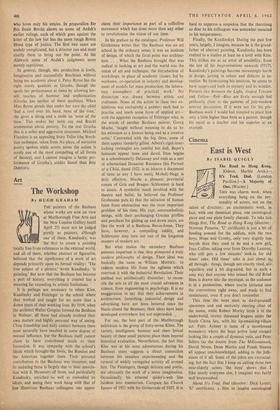Art
The Workshop
By HUGH GRAHAM
It is perhaps not necessary to relate Klee, Kandinsky and Feininger to the school where they worked and taught for no more than a dozen years of their working lives. By 1919, when the architect Walter Gropius formed the Bauhaus in Weimar, all three had already evolved their own mature and highly personal way of seeing. Close friendship and daily contact between them must naturally have resulted in some degree of mutual influence, but the Bauhaus itself cannot claim to have contributed much to their formation. It was sympathy with the school's ideals which brought•the Swiss, the Russian and the American together there. Their personal contribution to the Bauhaus was immense, and its enduring fame is largely due to their associa- tion with it. However,: all three, and particularly Kandinsky, enriched.'as well as embodied its ideals, and seeing their work hung with that of less' illustrious Bauhaus colleagues one appre- ciates their importance as part of a collective movement which has done more than any other to revolutionise the vision of our time.
In his preface to the catalogue. Professor Will Grohmann writes that 'the Bauhaus was no art school in the ordinary sense; it was an institute of design, of which the focal point was architec- ture. . . . What the Bauhaus brought that was radical in looking at art and the world was the union of art and technique, the introduction of workshops, in place of academic classes, led by workmen, co-operation in industry and develop- ment of models for mass production, the labora- tory atmosphere of practical work.' No distinction was drawn between artists and craftsmen. None of the artists in these two ex- hibitions was exclusively a painter; each had to practise and teach some form of applied art— with the apparent exception of Feininger who, in the words of another Bauhaus painter, Georg Muche, 'taught without meaning to do so by his existence as a human being and as a creative artist.' Contrasted with the big three, some of them appear slenderly gifted. Albers's rigid inter- locking rectangles are tasteful but dull, Bayer's fantasies appear tame and dated, Itten begins as a schoolmasterly Delaunay and ends as a sort of schematised Douanier Rousseau (his Portrait of a Child, dated 1922, is as bizarre a document of taste as any I have seen), Moholy-Nagy is drily effective, Muche a pleasant provincial cousin of Gris and Braque. Schlemmer is hard to assess. A symbolist much involved with the theatre and ballet, he believed (as Professor Grohmann puts it) that the salvation of human form from abstraction was the most important problem of his time. His rapt, somnambulistic beings, with their unchanging Grecian profiles and penchant for gliding up and down stairs, are like the work of a Bauhaus Burne-Jones. They have, however, a compelling oddity, and Schlemmer may turn out one of the forgotten masters of modern art.
But what makes the secondary Bauhaus • painters important is that they pioneered a truly modern philosophy of design. Their ideal was basically the same as William Morris's: to redeem modern life from the ugliness which overtook it with the Industrial Revolution. Their method was antithetically dissimilar: to recon- cile the arts to all the most crucial advances in science, from engineering to psychology. It is no exaggeration to say that their achievements in architecture, furnishing, industrial design and advertising have not been bettered since the Nazis closed the Bauhaus; their ideas have been developed everywhere but not superseded.
For me, the best part of the Marlborough exhibition is the group of forty-seven Klees. The variety, intelligence, humour and sheer lyrical beauty of these small pictures place them beyond historical evaluation. Nevertheless, the fact that Klee was at his most adventurous during his Bauhaus years suggests a direct connection between his ceaseless experimenting and the turmoil of widely variegated activity all around him. The Feiningers, though delicate and poetic, are obviously the work of a lesser imagination. Occasionally his ethereal spider's-web line hardens into mannerism. Compare his Church Square of 1921 with his Gelmeroda of 1927. It is hard to suppress a suspicion that the theorising so dear to his colleagues was somewhat unsuited to his temperament.
Finally, the Kandinskys. During the past few years, largely, I imagine, because he is the grand- father of abstract painting, Kandinsky has been exalted to a station at least on a level with Klee. This strikes me as an error of sensibility; from the last of his Improvisations onwards (1917), Kandinsky's paintings become increasingly harsh in design, jarring in colour and didactic in in- tention. By formulating his intuition, he seems to have suppre,sed both its mystery and its wonder. Pictures like Between the Light, Angled Tension and Yellow--Red—Blue are lively enough but perilously close to the patterns of jazz-modern interior decoration. If it were not for his pre- Bauhaus work I would feel tempted to place him only a little higher than Itten as a painter, though his equal as a teacher and his superior as an example.


































 Previous page
Previous page